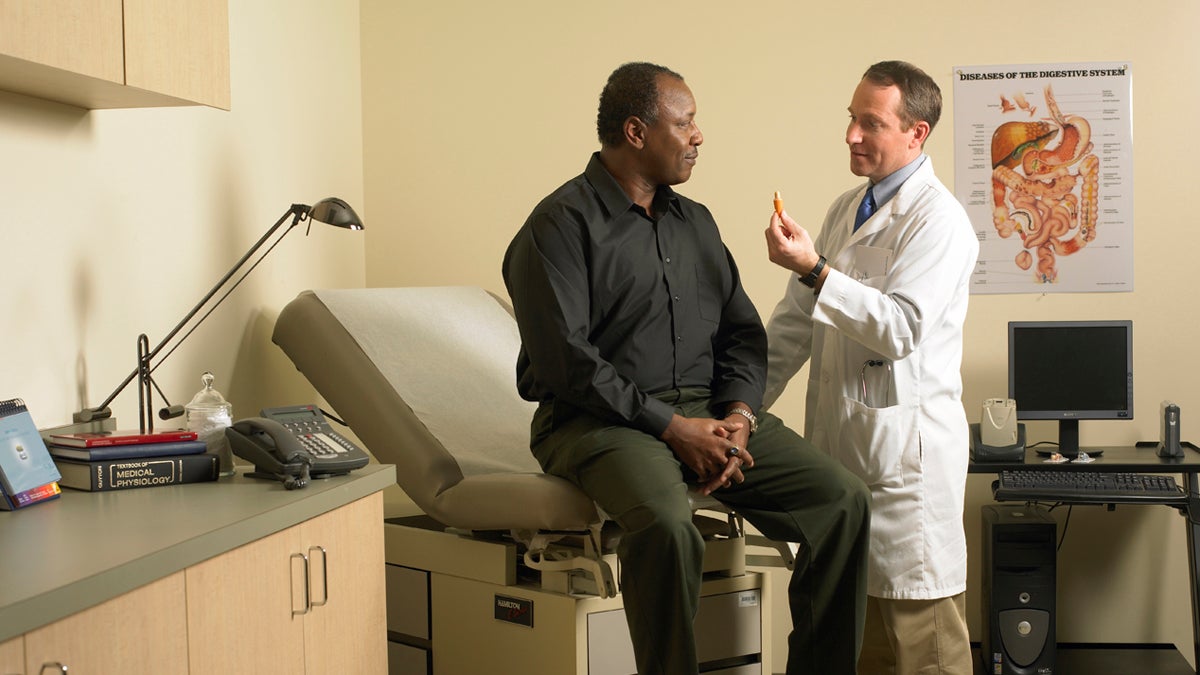Could swallowable cameras replace the colonoscopy?
Listen
(Photo courtesy of Given Imaging)
For reasons that are never made completely clear, gastroenterologist Mitchell Conn keeps a hard-sided case under his desk at Thomas Jefferson University Hospital. Coiled inside is a nine-foot long scope that, according to Conn, represented the height of gastrointestinal technology in the 1990s.
“This was how we would do small bowel endoscopy,” he says, pulling the tube out of its protective padding. “I pass it through the patient’s nose and into the stomach. Then I put a scope down through the mouth, and then drag it down to the small bowel.”
Then, over the course of eight hours, with the patient awake, Conn would slowly retract the scope, peering at the walls of the small intestine through a port.
For patients with hard-to-diagnose bleeding, this was the best way to pinpoint the source of the problem. It was also the stuff of nightmares.
So when the FDA approved a swallowable camera to diagnose problems in the small bowel in 2001, the field quickly took up the technology.
Given Imaging, an Israeli medical device company, originally marketed its breakthrough as the M2A (mouth to anus) capsule, but later rebranded it the PillCam. About the size of a large multi-vitamin, it contains tiny cameras that take tens of thousands of pictures as it snakes through the digestive tract.
The patient wears a recording device on his or her waist, which stores the images. They then get uploaded to a computer, allowing a doctor to review them.
“I was cynical when a small bowel capsule came out,” says Conn. “But I couldn’t believe how good it was.”
He says swallowable devices such as PillCam and its competitors are now the gold standard for viewing the small intestine.
But to get a look inside the large intestine, doctors and patients are still limited to the colonoscopy, an invasive and often dreaded exam endured 14 million times annually.
A long, deflated balloon
Just why the colonoscopy remains the most used tool for colorectal cancer screenings has to do with the shape and texture of the final five feet of our digestive tract.
“While the small intestine has the same diameter as the capsule–so as the capsule travels the small intestine, the capsule is able to look around very well–in the colon, which is three times the diameter, the tissue is collapsing around the capsule,” says Pietro Valdastri, a researcher at Vanderbilt University.
He says picture the colon as a long, deflated balloon. (In fact, Valdastri’s laboratory has used condoms sewn together to test prototype capsules.) To get around the visual challenges posed by the floppy walls of the colon, traditional colonoscopies use insufflation, the pumping in of air or liquid, to expand the cavity.
Pill cameras in the colon, however, move through the tract unaided, producing limited results. Given Imaging, now owned by Medtronic, won FDA approval in 2014 for a large intestine screening capsule, but only in patients who weren’t otherwise able to complete a traditional colonoscopy. A large study of PillCam COLON found it frequently failed to spot polyps that were likely to be picked up with a colonoscopy.
“Another main problem is the capsule has no way to interact with the tissue, so there is no way to get a tissue sample,” says Valdastri. At this point, the devices are purely diagnostic. When a potentially cancerous polyp is detected, patients still then need to undergo a colonoscopy.
Swallowable cameras also don’t eliminate what is often the most uncomfortable portion of the colonoscopy: flushing the bowel with large quantities of purging liquids, resulting in frequent bathroom trips. PillCam COLON, in fact, requires consuming more fluid than a colonoscopy.
With these shortcomings on the table, Given Imaging, Valdastri’s research laboratory, and many others are working on next generation swallowables. Everyone in the field is well aware how badly patients want an improved option for colorectal screenings.
“Hey, I’ve been in investor presentations when Given has gotten up there and showed how big this little camera pill is. And you can see, everybody in the audience are eager to raise their hands and say, ‘I want that,'” says Debbie Wang, an analyst with the research group Morningstar.
She says while demand is there, there are other factors at play.
“For gastroenterologists, doing a traditional colonoscopy is a big part of their bread and butter.”
PillCams cost around $600 for the colon version; less than a traditional colonoscopy, which often comes with the extra expense of an anesthesiologist, not to mention facility fees.
Another issue is time: a doctor can perform a colonoscopy in as little as 20 minutes, but reviewing thousands of pictures from a capsule takes an hour. That means slowing down a busy-practice, potentially cutting into a physician’s income.
“If you want to be real, the reality is, if you get more people screened, you’ll find more things, and you’ll actually do more colonoscopies,” says Mitchell Conn with Thomas Jefferson University Hospital, which will become the first facility in the region to offer PillCam COLON later this summer. “So if you want to look at it from a financial aspect, it is probably not going to affect the bottom line for gastroenterologists.”
But he adds even if these devices did impact physician earnings, it would be worth it, if it meant more patients underwent colorectal cancer screenings who wouldn’t otherwise go through a colonoscopy.
WHYY is your source for fact-based, in-depth journalism and information. As a nonprofit organization, we rely on financial support from readers like you. Please give today.



